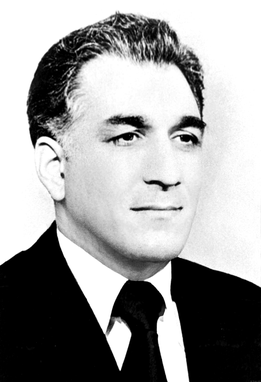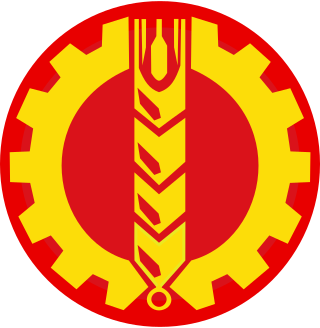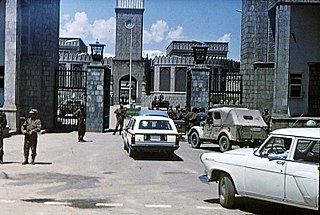
Babrak Karmal was an Afghan communist revolutionary and politician who was the leader of Afghanistan, serving in the post of general secretary of the People's Democratic Party of Afghanistan from 1979 to 1986.

The Brezhnev Doctrine was a Soviet foreign policy that proclaimed that any threat to "socialist rule" in any state of the Soviet Bloc in Central and Eastern Europe was a threat to all of them, and therefore, it justified the intervention of fellow socialist states. It was proclaimed in order to justify the Soviet-led occupation of Czechoslovakia earlier in 1968, with the overthrow of the reformist government there. The references to "socialism" meant control by the communist parties which were loyal to the Kremlin. Soviet leader Mikhail Gorbachev repudiated the doctrine in the late 1980s, as the Kremlin accepted the peaceful overthrow of Soviet rule in all its satellite countries in Eastern Europe.

Hafizullah Amin was an Afghan communist head of state, who served from September 1979 until his assassination. He organized the Saur Revolution of 1978 and co-founded the Democratic Republic of Afghanistan (DRA), ruling Afghanistan as General Secretary of the People's Democratic Party.
A satellite state or dependent state is a country that is formally independent but under heavy political, economic, and military influence or control from another country. The term was coined by analogy to planetary objects orbiting a larger object, such as smaller moons revolving around larger planets, and is used mainly to refer to Central and Eastern European member states of the Warsaw Pact during the Cold War, as well as to Mongolia and Tuva between 1924 and 1990, all of which were economically, culturally, and politically dominated by the Soviet Union. While primarily referring to the Soviet-controlled states in the Central and Eastern Europe or Asia, in some contexts the term also refers to other countries under Soviet hegemony during the Cold War, such as North Korea, Cuba, and some countries in the American sphere of influence, such as South Vietnam. In Western usage, the term has seldom been applied to states other than those in the Soviet orbit. In Soviet usage, the term applied to states in the orbit of Nazi Germany, Fascist Italy, and Imperial Japan, whereas in the West the term to refer to those has typically been client states.

The Democratic Republic of Afghanistan (DRA), renamed the Republic of Afghanistan in 1987, was the Afghan state during the one-party rule of the People's Democratic Party of Afghanistan (PDPA) from 1978 to 1992. It relied heavily on assistance from the Soviet Union for most of its existence, especially during the Soviet–Afghan War.

The Soviet–Afghan War was a protracted armed conflict fought in the Soviet-controlled Democratic Republic of Afghanistan (DRA) from 1979 to 1989. The war was a major conflict of the Cold War as it saw extensive fighting between the DRA, the Soviet Union and allied paramilitary groups against the Afghan mujahideen and their allied foreign fighters. While the mujahideen were backed by various countries and organizations, the majority of their support came from Pakistan, the United States, the United Kingdom, China, Iran, and the Arab states of the Persian Gulf. The involvement of the foreign powers made the war a proxy war between the United States and the Soviet Union. Combat took place throughout the 1980s, mostly in the Afghan countryside. The war resulted in the deaths of approximately 3,000,000 Afghans, while millions more fled from the country as refugees; most externally displaced Afghans sought refuge in Pakistan and in Iran. Approximately 6.5% to 11.5% of Afghanistan's erstwhile population of 13.5 million people is estimated to have been killed over the course of the conflict. The Soviet–Afghan War caused grave destruction throughout Afghanistan and has also been cited by scholars as a significant factor that contributed to the dissolution of the Soviet Union, formally ending the Cold War.

The People's Democratic Party of Afghanistan (PDPA) was a Marxist–Leninist political party in Afghanistan established on 1 January 1965. Four members of the party won seats in the 1965 Afghan parliamentary election, reduced to two seats in 1969, albeit both before parties were fully legal. For most of its existence, the party was split between the hardline Khalq and moderate Parcham factions, each of which claimed to represent the "true" PDPA.

Adolph Dubs, also known as Spike Dubs, was an American diplomat who served as the United States Ambassador to Afghanistan from May 13, 1978, until his death in 1979. He was killed during a rescue attempt after his kidnapping.

Nur Muhammad Taraki was an Afghan revolutionary communist politician, journalist and writer. He was a founding member of the People's Democratic Party of Afghanistan (PDPA) who served as its General Secretary from 1965 to 1979 and Chairman of the Revolutionary Council from 1978 to 1979.

The Saur Revolution or Sowr Revolution, also known as the April Revolution or the April Coup, was staged on 27–28 April 1978 by the People's Democratic Party of Afghanistan (PDPA) and overthrew Afghan president Mohammed Daoud Khan, who had himself taken power in the 1973 Afghan coup d'état and established an autocratic one-party system in the country. Daoud and most of his family were executed at the Arg in the capital city of Kabul by Khalqi military officers, after which his supporters were also purged and killed. The successful PDPA uprising resulted in the creation of a socialist Afghan government that was closely aligned with the Soviet Union, with Nur Muhammad Taraki serving as the PDPA's General Secretary of the Revolutionary Council. Saur or Sowr is the Dari-language name for the second month of the Solar Hijri calendar, during which the events took place.

The Afghan mujahideen (Pashto: افغان مجاهدين) were Islamist resistance militias that fought the Democratic Republic of Afghanistan and the Soviet Union during the Soviet–Afghan War and the subsequent First Afghan Civil War.

The Sarandoy or Tsarandoi were a gendarmerie force of the Soviet-backed Democratic Republic of Afghanistan in the 1980s, during the Soviet–Afghan War.

Pir Sayyid Ahmed Gailani, was the leader (Pir) of the Qadiriyyah Sufi order in Afghanistan, and the founder of the National Islamic Front of Afghanistan, a party that was associated with the Mujahideen who led the war against the Soviet Union in the 1980s.
Settam-e-Melli was a political movement in Afghanistan, led by Tahir Badakhshi. The organization was affiliated with the Non-Aligned Movement, and was opposed by both the Afghan monarchy and by the Soviet-aligned People's Democratic Party of Afghanistan. Its followers were mostly Persian speakers. Most of its members were non-Pashtuns—Tajik, Uzbek, and other minorities—and it has been variously described as an anti-Pashtun separatist group and as a Tajik and Uzbek separatist group. "Information on Settam-e-Melli is vague and contradictory, but it appears to have been an anti-Pashtun leftist mutation."
The Revolutionary Council of Islamic Unity of Afghanistan was a Hazara political movement which appeared in Afghanistan in 1979 in opposition to the increasingly leftist Kabul government. The movement was led by Sayyid Ali Beheshti.

The Republic of Afghanistan was the first republic in Afghanistan. It is often called the Daoud Republic or the Jamhuriyye-Sardaran, as it was established in July 1973 after General Sardar Mohammad Daoud Khan of the Barakzai dynasty alongside senior Barakzai Princes deposed his cousin, King Mohammad Zahir Shah, in a coup d'état. The occcasion for the coup was the 1964 Constitution of Afghanistan, that took power from most members of the royal family, in favour of the centralization under Zahir Shah and his offspring under the tenet of democracy. Daoud Khan was known for his autocracy and attempts to modernize the country with help from both the Soviet Union and the United States, among others.

Major General Sayed Muhammad Gulabzoi is an Afghan politician. An ethnic Pashtun from the Zadran tribe, Gulabzoi was born in Paktia Province. An Air Force mechanic by training, he studied at the Air Force college. As an air force officer, he supported Daoud Khan's 1973 coup d'état which overthrew King Zahir Shah, for which he was rewarded with the position of Aide to the Air Force Commander. In 1976, he went to the Soviet Union to study radar technology.

The Herat uprising, locally known as the Uprising of 24th Hūt was an insurrection that took place in and around the city of Herat in western Afghanistan, across several days in March 1979. It included both a popular uprising and a mutiny of ethnic Tajik Afghan Army troops against the Democratic Republic of Afghanistan (DRA). The communist regime at first appealed to its Soviet allies for help, but the Soviet leadership declined to intervene. After the insurgents seized and held the city for about a week, the regime was able to retake it with its own forces, and the subsequent aerial bombardment and recapture of Herat left 3,000 to 25,000 of its inhabitants dead. It was the worst outbreak of armed violence in the country in 50 years, and was the deadliest incident in the 1978-1979 period following the Saur Revolution and before the start of the Soviet occupation.
As a geographically fragmented state, Afghanistan is separated into as many as 14 ethnic groups that have historically faced divisions that devolved into political violence. This conflict reached its culminating point in the 1990s with the rise of the Taliban.
Women in the Soviet–Afghan War were active in a variety of roles.














